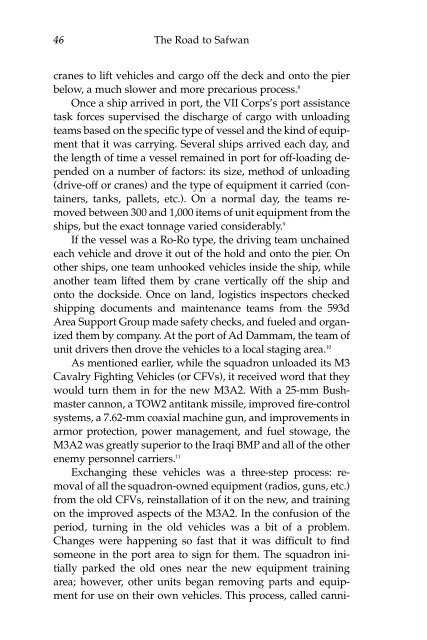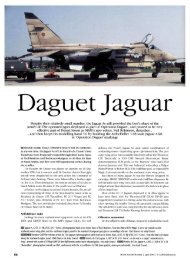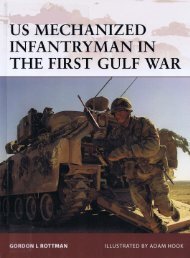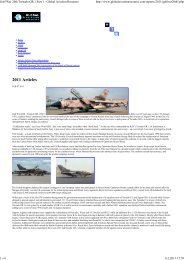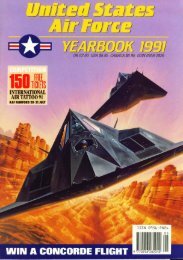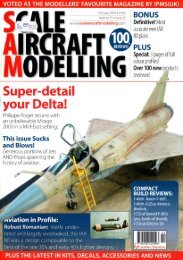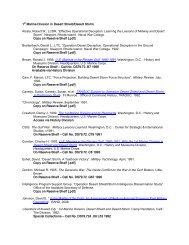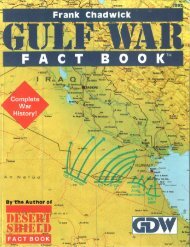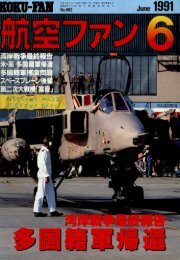The Road to Safwan: The 1st Squadron, 4th Cavalry in the 1991 ...
The Road to Safwan: The 1st Squadron, 4th Cavalry in the 1991 ...
The Road to Safwan: The 1st Squadron, 4th Cavalry in the 1991 ...
You also want an ePaper? Increase the reach of your titles
YUMPU automatically turns print PDFs into web optimized ePapers that Google loves.
46 <strong>The</strong> <strong>Road</strong> <strong>to</strong> <strong>Safwan</strong><br />
cranes <strong>to</strong> lift vehicles and cargo off <strong>the</strong> deck and on<strong>to</strong> <strong>the</strong> pier<br />
below, a much slower and more precarious process. 8<br />
Once a ship arrived <strong>in</strong> port, <strong>the</strong> VII Corps’s port assistance<br />
task forces supervised <strong>the</strong> discharge of cargo with unload<strong>in</strong>g<br />
teams based on <strong>the</strong> specific type of vessel and <strong>the</strong> k<strong>in</strong>d of equipment<br />
that it was carry<strong>in</strong>g. Several ships arrived each day, and<br />
<strong>the</strong> length of time a vessel rema<strong>in</strong>ed <strong>in</strong> port for off-load<strong>in</strong>g depended<br />
on a number of fac<strong>to</strong>rs: its size, method of unload<strong>in</strong>g<br />
(drive-off or cranes) and <strong>the</strong> type of equipment it carried (conta<strong>in</strong>ers,<br />
tanks, pallets, etc.). On a normal day, <strong>the</strong> teams removed<br />
between 300 and 1,000 items of unit equipment from <strong>the</strong><br />
ships, but <strong>the</strong> exact <strong>to</strong>nnage varied considerably. 9<br />
If <strong>the</strong> vessel was a Ro-Ro type, <strong>the</strong> driv<strong>in</strong>g team uncha<strong>in</strong>ed<br />
each vehicle and drove it out of <strong>the</strong> hold and on<strong>to</strong> <strong>the</strong> pier. On<br />
o<strong>the</strong>r ships, one team unhooked vehicles <strong>in</strong>side <strong>the</strong> ship, while<br />
ano<strong>the</strong>r team lifted <strong>the</strong>m by crane vertically off <strong>the</strong> ship and<br />
on<strong>to</strong> <strong>the</strong> dockside. Once on land, logistics <strong>in</strong>spec<strong>to</strong>rs checked<br />
shipp<strong>in</strong>g documents and ma<strong>in</strong>tenance teams from <strong>the</strong> 593d<br />
Area Support Group made safety checks, and fueled and organized<br />
<strong>the</strong>m by company. At <strong>the</strong> port of Ad Dammam, <strong>the</strong> team of<br />
unit drivers <strong>the</strong>n drove <strong>the</strong> vehicles <strong>to</strong> a local stag<strong>in</strong>g area. 10<br />
As mentioned earlier, while <strong>the</strong> squadron unloaded its M3<br />
<strong>Cavalry</strong> Fight<strong>in</strong>g Vehicles (or CFVs), it received word that <strong>the</strong>y<br />
would turn <strong>the</strong>m <strong>in</strong> for <strong>the</strong> new M3A2. With a 25-mm Bushmaster<br />
cannon, a TOW2 antitank missile, improved fire-control<br />
systems, a 7.62-mm coaxial mach<strong>in</strong>e gun, and improvements <strong>in</strong><br />
armor protection, power management, and fuel s<strong>to</strong>wage, <strong>the</strong><br />
M3A2 was greatly superior <strong>to</strong> <strong>the</strong> Iraqi BMP and all of <strong>the</strong> o<strong>the</strong>r<br />
enemy personnel carriers. 11<br />
Exchang<strong>in</strong>g <strong>the</strong>se vehicles was a three-step process: removal<br />
of all <strong>the</strong> squadron-owned equipment (radios, guns, etc.)<br />
from <strong>the</strong> old CFVs, re<strong>in</strong>stallation of it on <strong>the</strong> new, and tra<strong>in</strong><strong>in</strong>g<br />
on <strong>the</strong> improved aspects of <strong>the</strong> M3A2. In <strong>the</strong> confusion of <strong>the</strong><br />
period, turn<strong>in</strong>g <strong>in</strong> <strong>the</strong> old vehicles was a bit of a problem.<br />
Changes were happen<strong>in</strong>g so fast that it was difficult <strong>to</strong> f<strong>in</strong>d<br />
someone <strong>in</strong> <strong>the</strong> port area <strong>to</strong> sign for <strong>the</strong>m. <strong>The</strong> squadron <strong>in</strong>itially<br />
parked <strong>the</strong> old ones near <strong>the</strong> new equipment tra<strong>in</strong><strong>in</strong>g<br />
area; however, o<strong>the</strong>r units began remov<strong>in</strong>g parts and equipment<br />
for use on <strong>the</strong>ir own vehicles. This process, called canni-


